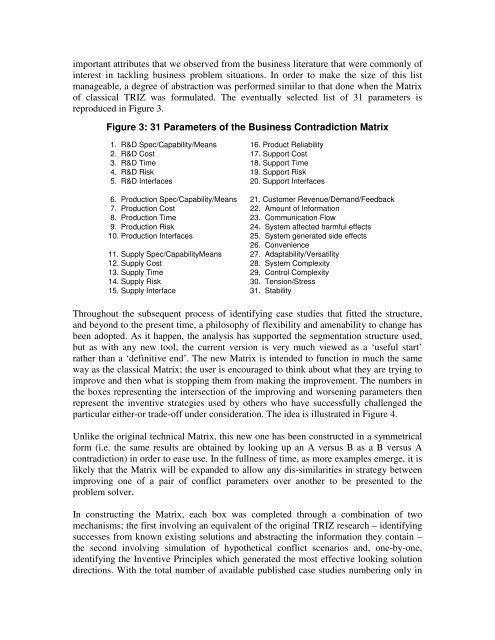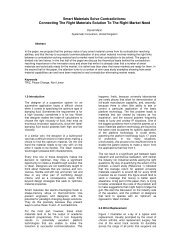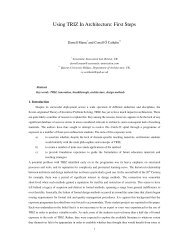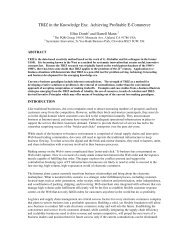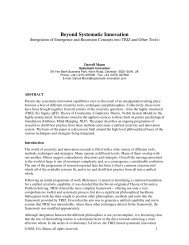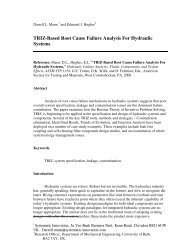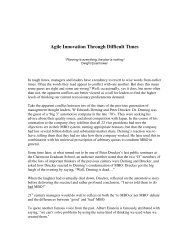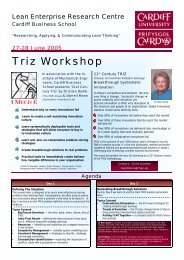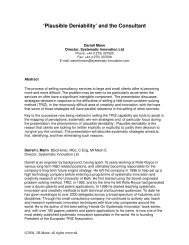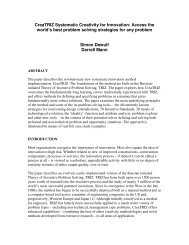systematic win-win problem solving in a business environment
systematic win-win problem solving in a business environment
systematic win-win problem solving in a business environment
You also want an ePaper? Increase the reach of your titles
YUMPU automatically turns print PDFs into web optimized ePapers that Google loves.
important attributes that we observed from the bus<strong>in</strong>ess literature that were commonly of<br />
<strong>in</strong>terest <strong>in</strong> tackl<strong>in</strong>g bus<strong>in</strong>ess <strong>problem</strong> situations. In order to make the size of this list<br />
manageable, a degree of abstraction was performed similar to that done when the Matrix<br />
of classical TRIZ was formulated. The eventually selected list of 31 parameters is<br />
reproduced <strong>in</strong> Figure 3.<br />
Figure 3: 31 Parameters of the Bus<strong>in</strong>ess Contradiction Matrix<br />
1. R&D Spec/Capability/Means<br />
2. R&D Cost<br />
3. R&D Time<br />
4. R&D Risk<br />
5. R&D Interfaces<br />
6. Production Spec/Capability/Means<br />
7. Production Cost<br />
8. Production Time<br />
9. Production Risk<br />
10. Production Interfaces<br />
11. Supply Spec/CapabilityMeans<br />
12. Supply Cost<br />
13. Supply Time<br />
14. Supply Risk<br />
15. Supply Interface<br />
16. Product Reliability<br />
17. Support Cost<br />
18. Support Time<br />
19. Support Risk<br />
20. Support Interfaces<br />
21. Customer Revenue/Demand/Feedback<br />
22. Amount of Information<br />
23. Communication Flow<br />
24. System affected harmful effects<br />
25. System generated side effects<br />
26. Convenience<br />
27. Adaptability/Versatility<br />
28. System Complexity<br />
29. Control Complexity<br />
30. Tension/Stress<br />
31. Stability<br />
Throughout the subsequent process of identify<strong>in</strong>g case studies that fitted the structure,<br />
and beyond to the present time, a philosophy of flexibility and amenability to change has<br />
been adopted. As it happen, the analysis has supported the segmentation structure used,<br />
but as with any new tool, the current version is very much viewed as a ‘useful start’<br />
rather than a ‘def<strong>in</strong>itive end’. The new Matrix is <strong>in</strong>tended to function <strong>in</strong> much the same<br />
way as the classical Matrix; the user is encouraged to th<strong>in</strong>k about what they are try<strong>in</strong>g to<br />
improve and then what is stopp<strong>in</strong>g them from mak<strong>in</strong>g the improvement. The numbers <strong>in</strong><br />
the boxes represent<strong>in</strong>g the <strong>in</strong>tersection of the improv<strong>in</strong>g and worsen<strong>in</strong>g parameters then<br />
represent the <strong>in</strong>ventive strategies used by others who have successfully challenged the<br />
particular either-or trade-off under consideration. The idea is illustrated <strong>in</strong> Figure 4.<br />
Unlike the orig<strong>in</strong>al technical Matrix, this new one has been constructed <strong>in</strong> a symmetrical<br />
form (i.e. the same results are obta<strong>in</strong>ed by look<strong>in</strong>g up an A versus B as a B versus A<br />
contradiction) <strong>in</strong> order to ease use. In the fullness of time, as more examples emerge, it is<br />
likely that the Matrix will be expanded to allow any dis-similarities <strong>in</strong> strategy between<br />
improv<strong>in</strong>g one of a pair of conflict parameters over another to be presented to the<br />
<strong>problem</strong> solver.<br />
In construct<strong>in</strong>g the Matrix, each box was completed through a comb<strong>in</strong>ation of two<br />
mechanisms; the first <strong>in</strong>volv<strong>in</strong>g an equivalent of the orig<strong>in</strong>al TRIZ research – identify<strong>in</strong>g<br />
successes from known exist<strong>in</strong>g solutions and abstract<strong>in</strong>g the <strong>in</strong>formation they conta<strong>in</strong> –<br />
the second <strong>in</strong>volv<strong>in</strong>g simulation of hypothetical conflict scenarios and, one-by-one,<br />
identify<strong>in</strong>g the Inventive Pr<strong>in</strong>ciples which generated the most effective look<strong>in</strong>g solution<br />
directions. With the total number of available published case studies number<strong>in</strong>g only <strong>in</strong>


